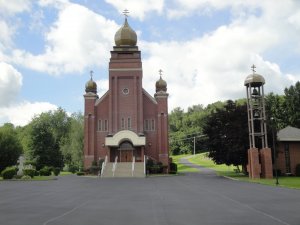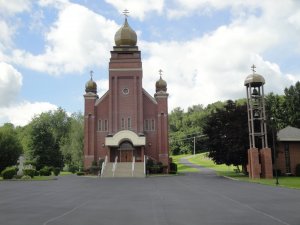Remember, Icons are not "painted", they are written...

You can call it whatever you want, but to insist that others do on ridiculously untenable linguistic grounds is absurd. There are several good articles on the subject, but the gist is that when the Greek word has more than one meaning, we should choose the one that most aligns with what we are doing, and that meaning is "paint." This is not to deny the complimentary nature of the icon and the written word, but in fact to make it clear that they are not synonymous but indeed complimentary.
Are there rituals and prayers involved while producing the icons? Is there anything ritual or blessing performed on them after production?
I would be lying if I said there weren't rituals and prayers involved, but they vary from person to person depending on what you have been taught, or what you have been given as an obedience. It is important to understand that it is not the holiness of the iconographer that makes an icon holy, it is the image itself and its connection to the person depicted. That being said, if some spirit-bearing elder gave me a brick or a handful of sand for whatever reasons he might have, I would treasure it. An icon painted by someone truly holy can't help but be special in some way, but holiness does not depend on the piety or lack thereof of the person holding the brush. All iconographers should be living lives of prayer, fasting, and alms-giving, not because they are iconographers, but because they are Christians. And like all Christians, their prayer rule will depend on their spiritual father and their own spiritual maturity.
There are blessings for icons, though this is problematic given that in defending icons against the iconoclasts one of the arguments the fathers made was that there is no prayer of blessing for icons, they are holy because of the image that they bear. With that being said, I think as long as we view this as a dedication of an icon rather than a "consecration" meant to unite a prototype and an image in some sort of consubstantial way, it does not have to be problematic. I usually have my icons blessed by having them placed on the altar because as an iconographer I feel that it serves as a reminder that it is not my work alone.
Are the icons believed to be charmed in some way or do they bestow something on the viewer?
Charmed would be a weird word with potentially magical connotations. They are certainly blessings in our lives, they are vehicles by which the grace of God is imparted to us, they are a connection to the people depicted, and they can be used by God's mercy for great wonders and miracles both bodily and spiritual.
Likewise, can an icon be cursed or corrupted and cause harm.
I can't think of how this would work, except to say that if the Eucharist can be damaging if received unworthily, so too could an icon be used in a counterproductive way. What comes to mind is the story of the icon of the Mother of God Unexpected Joy.
Icon of the Mother of God “The Unexpected Joy”
While the icon had a positive effect, it was despite his efforts to use it for his own purposes. Had he persisted, I could see where it might have been a cause of harm in a sense.
Do you have to be Orthodox to create an authentic or acceptable icon?
Because the holiness of the image does not lie in the worthiness of the painter, I think it is possible for God to use an icon by a non-Orthodox Christian in positive ways, but in general, if you are Orthodox, it would be a far better practice to get your icons from Orthodox Christians who are hopefully knowledgeable about our tradition and steeped in it.
Are the portraits of specific saints based on previous interpretations of the same saints or it up the artist to select models?
Because the images are tied to the prototypes, it would generally be a poor idea to use a model for painting an icon since you would be more likely to create a link between the model and the image than the saint and the image. That being said, there is nothing wrong with doing figure studies and learning from live models how to sketch or paint. But we should be going back to the tradition for how a saint looked. In very few cases there is not a ready prototype, and in those cases we must depict the Saint using what we do know about them and the usual depictions of Saints in a similar class. In frequent cases Saints have appeared to iconographers in order to know how they should be painted.
Are there any Christian subjects or themes that are off limits?
If "Christian" is properly defined, then I would say no. But you will see icons of the Sacred Heart which is not acceptable within an Orthodox framework. Depictions of God the Father, while frequently found in Orthodox Churches create issues in our understanding of the depictability of the Divine nature and the uniqueness of the Incarnation of Christ. So we must understand what is truly Christian before we create icons according to our understanding.
Are there prescribed mediums and supports?
If there is a preference in the writings of the Fathers, I would say it is for Encaustic. Beyond that we are told to use "suitable materials." I am very disturbed by those who have created a theology behind the materials because the Fathers make it clear that the holiness of the icon does not lie in the matter itself though matter is sanctified. That said, if someone prefers egg tempera, as many do, then use egg tempera.
Are there prescribed symbols used?
The word symbol can be problematic when speaking of icons, but there are certainly certain artistic, visual conventions that are part of the creation of icons, and while we should not be quick to assume that we understand the meaning of every element in an icon (nor that every element has a specific meaning) I think it is good to view some of these things as a sort of mystagogical or interpretive layer that helps to bring us to prayer and greater piety. We should not think that these opinions have a dogmatic quality, but are rather pious reflections.
I remember the icon screens from Byzantine Catholic churches. Is the culture or tradition of iconography similar to Byzantine Catholic?
Byzantine Catholics retain much of the form from their Orthodox roots, and this carries over very often in iconography as well.


